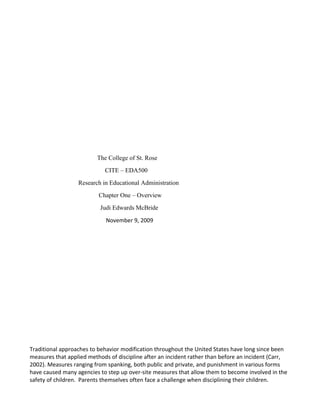
Judi Edwards McBride
- 1. The College of St. Rose CITE – EDA500 Research in Educational Administration Chapter One – Overview Judi Edwards McBride November 9, 2009 Traditional approaches to behavior modification throughout the United States have long since been measures that applied methods of discipline after an incident rather than before an incident (Carr, 2002). Measures ranging from spanking, both public and private, and punishment in various forms have caused many agencies to step up over-site measures that allow them to become involved in the safety of children. Parents themselves often face a challenge when disciplining their children.
- 2. A decline in self-discipline and social values among teenagers and youths has continually been on the rise. This change in behavior has crossed over into the educational system. Yet today, in this vastly changing world of NCLB and academic accountability, we see the trend shift from personal, individual responsibility to school wide responsibility (Epstein, 1992). This new approach no longer clings to the belief that parents are the major disciplinarians or have sole responsibility for the discipline of their children. The true meaning of “it takes a village” is not really there either. Yet, schools are now being held accountable and are jointly responsible with parents, for developing a positive home culture that will eventually lead to a positive school culture. In days gone by, typical conversation in public and private school has focused on the behavior of the “problem child” or “bad kid”. But now, in today’s climate of accountability for learning and meeting the needs of all students, no student can be overlooked. Gone are the days when the “good kids” are ignored. They no longer get just a gold star. The “bad kids” can’t just be suspended either. In both cases, specific recognition has to be given to the children working on task and behavior modifications must be put in place for those that have challenges when it comes to behavior. Here in lies the challenge for educators. How do we implement a program or programs that meet the needs of both types of students? And, what type of research will guide our decision? In chapter one of Methods in Educational Research: From Theory to Practice by Lodico, Spaulding and Voegtle (2007), , we are given an opportunity to explore the various methods of research and research techniques used in education. This review of educational research also describes NCBL and the relationship between the educational research requirements needed to meet the accountability standards set forth by the United States government. As we approach chapter one, we are reminded of the need for educational research and the lack there of in education. Among the many stakeholders, there is a consensus that educational research would indeed support the effort being made in schools to meet the educational research requirements of NCLB. What is that you might say? Well, according to NCLB, standards for accountability have been put in place along with additional funding for schools that implement programs that are “scientific and reliable”. According to Lodico, Spaulding and Voegtle, the 2001 NCLB act is a reauthorization of the Elementary and Secondary Education act of 1965 and calls for more involvement in education by the federal government. The legislation outlined by the federal government identifies specific areas where school must make significant, measurable adjustments in order to get school funding from the federal government. Annual funding, academic progress, school report cards, teacher quality, and reading first are the areas in which schools must comply. Like traditional research, educational research also uses the scientific method. This research outlines specific types of research and the ways in which they should be used. Inductive reasoning, deductive, hypothetic- deductive, qualitative, and quantitative research are all methods of research used in education. These research methods use hypothesis, theories and generalizations to begin the process of scientific educational research. For the researcher, the scientific method involves asking a question, collecting the data, analyzing the data, interpreting data and reporting the findings and finally generating a new question to ask next. Researchers, like educators, have different philosophical views. What it means for researchers is that their approach to educational research and the methods used can be entirely different based on their philosophical view. Social constructivism, advocacy, liberatory and pragmatism are also different
- 3. approaches to research used by educational researchers to guide their study. The underlying theory is that your philosophy will determine the type of research and research approach you will use in the process of determining what educational research method works best for you. As the approach to research continues, basic research and applied research are also identified. Developing theories that modify, refine and test are associated with basic research and applied research determines whether a practice is effective or not. The response to educational research is often through evaluation in the form of formative or summative feedback. The formative feedback would allow for changes to be made throughout the research process. Summative, on the other hand, would identify whether a task or goal was met at the end of the research process. There are many key terms and concepts that are introduced in chapter one. All of which lead to a greater understanding of educational research and the process or processes used to guide the different approaches used by researchers in the research process. A good start, these first pages you can also go into talking about your building and the issues surrounding behavior that you see in your building, then roll into the purpose statement, and then definitions and then your review of lit.